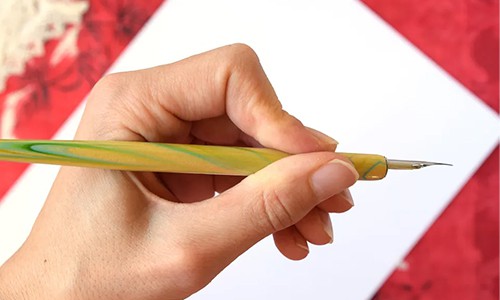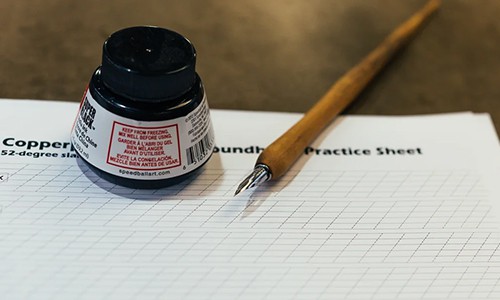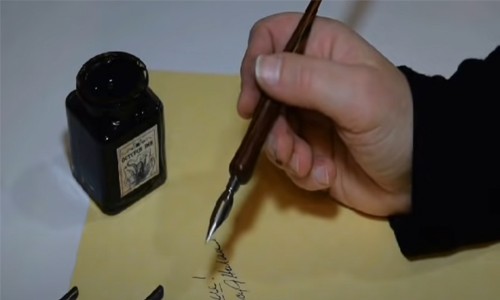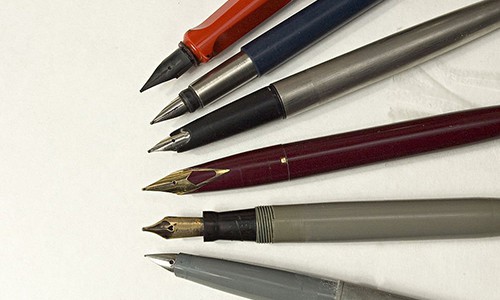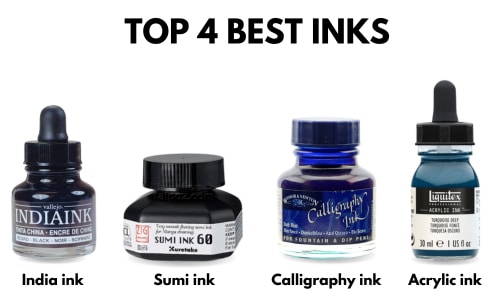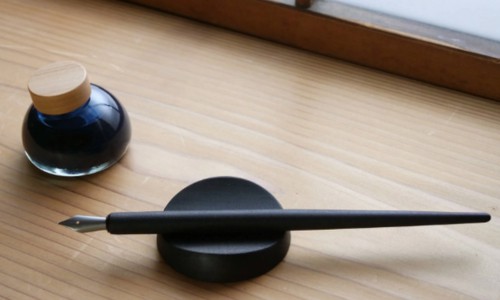Learning how to use a dip pen unfolds a unique writing experience that explores the world of classic craftsmanship. Whether it is for drawing, decorative writing, or calligraphy, dip pens are sophisticated implements that unlock limitless creative possibilities.
If you are a calligraphy enthusiast or an aspiring artist planning to use this writing tool for the first time, read on to learn the best tips to write with precision and refinement.
Table of Contents
In-depth Guidelines to Use a Dip Pen
Things You Will Need:
- Suitable dip pen nib
- Bottled ink (India or acrylic ink)
- High-quality thick paper
- Tissue or soft cloth
- A container filled with clean water
- A pen holder or pen rest
Step 1: Connect the Nib to Your Dip Pen
Gently put a nib in a dip pen and connect it to the nib holder correctly. Ensure it is neither loose nor tight but aligned properly within the holder.
Step 2: Dip the Nib into the Ink
Dip the pen into the bottled ink carefully and soak it for a few seconds.
Before doing so, take note of the reservoir hole (positioned in the middle of the nib). Make sure to lower the nib in the ink up to this level. Dipping the pen beyond the reservoir hole will result in messy ink spills.
Gently tap the nib on the container’s rim to remove any excess ink.
Step 3: Practice Writing
Before you write with a dip pen, find a comfortable grip. Hold it as you would a pencil, ensuring a 45-degree angle for an ample hand position.
Always start with light pressure. Avoid pressing too hard against the paper to ward off any ink blobs or nib damage.
Use scrap paper to practice your dip pen. This allows you to check the ink quality and establish an optimum flow for effortless writing or drawing.
It is best to practice writing with a few lines to determine the ideal and comfortable pressure to apply to your actual writing. Explore various angles and pressures to achieve your preferred writing or drawing results.
Step 4: Start Writing
After practicing and finding your preferred angle, pressure, and hand position, start writing two to three lines for a single dip.
Go for light pressure for narrow strokes and gradually increase it for thicker strokes. Since dip pens have small reservoirs, simply dip the pen again into the ink to write a few more lines.
Step 5: Rinse the Nib of Your Dip Pen Thoroughly
Rinsing the nib after every use is necessary to keep any ink residues from drying into your nibs. Otherwise, it will not work as it should and may lead to nib damage.
Use a container with clean warm water and dip the nib in it. Swish the nib gently in the water to thoroughly clean it.
Shake off any excess water and dry the nib with a soft, clean cloth.
Step 6: Retract the Nib Firmly and Slowly
Hold the nib carefully and slowly take it out from the holder.
Before storing or reusing, position the pen downward to allow any water on the nib mount to escape. Blot the nib with a tissue and make sure it is completely dry before storing it.
Step 7: Store the Pen Properly
Place the dip in a holder in an upright position without the nib facing downward. You may also use a dip pen rest.
Useful Tips and Reminders When Using a Dip Pen
1. Always Choose the Correct Nib Type
Since there are different types of nibs, it is imperative to check the compatibility of the nib to your dip pen. Some dip pens only work with specific nibs provided by the same manufacturer.
Take note that nibs come in different elasticity levels. The higher the elasticity, the more the nib will bend easily.
Thus, users who write with light pressure should go for nibs with higher elasticity, whereas low elastic nibs are for heavy-handed writers.
Choose fine or ultra-fine nibs for calligraphy, writing, and drawing. Large-scale projects or applications that require thick strokes should be used with broad nibs.
2. Choose the Correct Type of Ink
When choosing the best ink for your dip pen set, India ink, Sumi ink, calligraphy ink, and acrylic ink are the popular options. Each type renders a specific quality and appearance, suitable for a vast range of applications.
- India ink: The most popular ink type and very easy to find. Waterproof and gives off a semi-gloss finish. The ideal option for beginners.
- Sumi ink: It does not coagulate over time unlike India ink. Lends a semi-matte finish. However, it is very difficult to find.
- Calligraphy ink: Typically has thin consistency and needs a learning curve. Available in a vast spectrum of colors for projects requiring color assortment and depths.
- Acrylic ink: Another popular ink option for its water-resistant, quick-drying, versatile, workable, and smudge-proof characteristics. It is accessible and a great option for beginners.
3. Select a Compatible Nib Holder
Take note that every brand provides a selection of nib holders. Consider the following factors when finding one:
- Must be suitable for your nib.
- Should have a good weight and feel nice in your hand as you hold it.
- It should allow you to write comfortably with your preferred pressure and angle.
4. Choose High-Quality Paper
Choosing a suitable paper type is a prerequisite when learning how to use a nib pen. Always settle for high-quality thick paper, typically the ones with 70 GSM or higher.
Frequently Asked Questions
Can dip pens be used for calligraphy?
Yes, you can use a calligraphy dip pen to create nice lettering. Calligraphy is a sophisticated and decorative writing style that demands precise and controlled strokes. Dip pens provide optimum flexibility that renders line variation necessary for this artistic work.
What are glass dip pens used for?
Similar to regular dip pens, glass dip pens are most commonly used for writing, lettering, calligraphy, and sketching. They highlight their aesthetic features, particularly the transparent spiraling grooves that exhibit stunning colors when filled with ink.
If you use a glass dip pen, you can write more sentences than regular dip pens would. It’s all because the spiraling grooves can hold more ink for multiple applications.
Moreover, they are easy to clean, very durable (they never rust or clog!), and easy to use. Unfortunately, glass dip pens are fragile and should be cared for properly.
Aside from that, glass dip pens are well-suited for use with watercolor since they can handle both pigmented dip pen inks and diluted watercolor.
Are dip pens good for writing?
Yes, dip pens are one of the best writing implements to elevate your handwriting style.
Their versatile features allow users to render precise applications, varied line weights, and better control over their writing designs. Besides that, effortlessly switching between inks is one of the benefits of using dip pen sets.
Conclusion
Learning how to use a dip pen helps achieve numerous creative possibilities for artists, writers, and calligraphy enthusiasts alike. With the step-by-step instructions and practical tips provided, you can attain precision and added creativity in your projects.
With the correct nib, ink, paper, and practice, you may produce accurate and intricate work with a dip pen. Hopefully, after following the aforementioned steps, you can take your penmanship to a whole new level of artistry and craftsmanship.
Related article: Fountain Pens vs Dip Pens.

Art has always been a part of my life; it influences my upbringing and later my career choice. For me, it is always a part of my parenting technique. So for whichever purpose that you come to art, you can start here with us.


